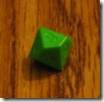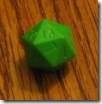Chances are, you’ve run a session that was less than stellar, and one of your players has given you the most common player boredom clue ever: stacking dice. Now, sure, when you see this cue, it’s important to re-evaluate the pacing of your adventure, but more importantly, you should be evaluating their dice stacking skills. After all, you’re the GM, and a player stacking dice at your table is a challenge, and should be interpreted and dealt with as such. This article and it’s follow-ups are designed to hone your dice-stacking skills so that you can fire back, building your own dice towers, bigger and better than anything your players can build, as they role play, describe their actions, and compete for your attention against your ever-growing plastic cityscape.
This installment of the Guide to Dice Stacking will deal with the basic uses of dice in a normal stack. While we’ll touch on more advanced techniques, you’ll have to wait for our next installment for detailed instructions on advanced gambits.
For the beginner, the d4 is best saved for a capstone piece. Yes, as a equilateral pyramid, the base for many polyhedral solids, the d4 is the base for some of the most complex dice stacking gambits, but until you master the basics, reserve d4s for topping your towers
The d6 is the most stable die, due to the positioning of the foot precisely under the top. This makes them excellent bases with which to start your stacks. D6s also have the largest foot of similar sized dice of all types, making them resistant to table motion. However, they also have the largest and least aerodynamic sides, making them the most susceptible to wind turbulence.
D8s are deceptively tricky to stack. While they have a nice large foot and top, they’re offset from each other by 50%. This means that towers using d8s have a tendency to fall towards the void under the die. When using d8s, try to build mirror stacks side by side so the d8’s prop each other up.
The D10:
 Â D10s are another die that are trickier to use than they look. While the foot and top are almost perfectly lined up, they’re inverted, meaning that the wide end of the top is balanced on the narrow end of the foot, so uneven weight distribution can easily roll the die to the side.
 D10s are another die that are trickier to use than they look. While the foot and top are almost perfectly lined up, they’re inverted, meaning that the wide end of the top is balanced on the narrow end of the foot, so uneven weight distribution can easily roll the die to the side.
Along with the d6, the d12 is the best basic stacking die. While it isn’t quite as stable and has a smaller foot, the d12 is much more aerodynamic, making the choice between d6s and d12s for your bases a matter of what kind of table interference is more likely to affect your towers.
The d20 is the third best basic stacking die. It’s foot and top align well, but they’re small and subject to a smaller degree to the same twisting as the d10. They also tend to be the largest die, making stacking them on top of any other die a little more challenging.
There are plenty of other dice types out there, from the ancient d30s to the newer “tube dice” variations of normal types of dice but few are true regular polyhedral solids (technically neither are d10s) and most are inappropriate for dice stacking. Show off your stacks and your oddballs on different days.
That’s all for this installment. These basics should have you making fairly impressive towers to show up that inattentive player in your group with just a little practice. Get stacking!























Tongue-in-cheek, I know, but I love it. 😉
As a GM, I’ve never had the time or inclination to stack dice. As a player, I — like most players; couldn’t agree with you more on that — stack dice when I’m bored, but also when it’s not “my turn.”
If someone else is having a solo extended RP scene, I’ll stack dice while paying attention. Not bored, just not involved.
Great article Matthew! I usually gravitate toward the hard core GM advice, but this one was sweet. And personal. I’ve spun a lot of dice as a player.
Looking forward to the advanced articles: dice spinning, spinning dice on a dice stack, and the best: spinning dice circle of death – last spinner wins. This one usually gets the other players involved.
Yeah, I’m _that_ player. That’s why I stick to GMing.
In a monumental feat of dyslexia, I read the title as “A Beginner’s Guide to Dice Rolling“.
I was all prepared to weigh in on the unwashed heathens who not only don’t actually shake their dice, but somehow manage to drop them onto the table so that they stop instantly rather than rolling.
Instead, I can only comment that, at our table, boredom is signalled by marshalling little status markers into proper rows and columns, sorted by color.
I’ve never stacked dice.
But we did build a tower out of pretzel sticks once. It rose to an incredible height before a stray oversized d20 careened into it and quickly ended our dreams for having the world’s largest Rold Gold construct recorded. 🙂
Great article. I have, as a player been guilty of this, in the past, but now make it a point out of respect to the GM to keep my dice flat, even if they are having a hard time.
What I need to do, is to scan my players more often, to make sure that they are not bored during parts of the game. I try to keep the game moving, but exciting for one player is not always exciting for the group. Dice stacking and other fidgeting are great signs of players who are starting to lose interest in the current scene.
@TwoShedsJackson –
To get a full treatise on dice rolling, get a copy of HackMaster Basic and refer to Chapter 12, on the proper care and handling dice.
It comes complete with pictures of how to perform the most common dice rolls, including the infamous 2-Fisted Monkey roll.
Thank you for this most excellent introduction to one of the oldest and most respected gaming-related activities.
I look forward to your article on the the proper etiquette of quoting Monty Python at the gaming table.